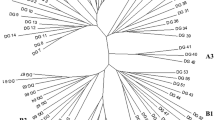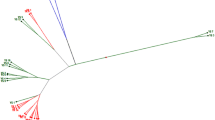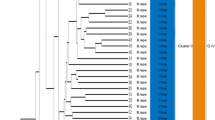Abstract
Oilseed rape (Brassica napus) is an important oilseed crop worldwide. Cultivars have been developed for many growing regions, however little is known about genetic diversity inB. napus germ plasm. The purpose of the research presented here was to study the genetic diversity and relationships ofB. napus accessions using restriction fragment length polymorphisms (RFLPs). Eighty threeB. napus accessions were screened using 43 genomic DNA clones which revealed 161 polymorphic fragments. Each accession was uniquely identified by the markers with the exception of the near-isogenic cvs ‘Triton’ and ‘Tower’. The RFLP data were analyzed by cluster analysis of similarity coefficients and by principal component analysis. Overall, there were three major groups of cultivars. The first group included only spring accessions, the second mostly winter accessions and the third, rutabagas and oilseed rape accessions from China and Japan. These results indicate that withinB. napus, winter and spring cultivars represent genetically distinct groups. The grouping of accessions by cluster analysis was generally consistent with known pedigrees. This consistency included the grouping of lines derived both by backcrossing or self-pollination with their parents.
Similar content being viewed by others
References
Beversdorf WD, Weiss-Lerman J, Erickson LR, Souza-Machado V (1980) Transfer of cytoplasmically-inherited triazine-resistance from bird's rape to cultivated oilseed rape (Brassica campestris andB. napus). Can J Genet Cytol 22:167–172
Brandle JE, McVetty PBE (1989a) Effects of inbreeding and estimates of additive genetic variance within seven summer oilseed rape cultivars. Genome 32:115–119
Brandle JE, McVetty PBE (1989b) Heterosis and combining ability in hybrids derived from oilseed rape cultivars and inbred lines. Crop Sci 29:1191–1195
Downey RK, Rakow GFW (1987) Rapeseed and mustard. In: Fehr WR (ed) Principles of cultivar development, vol. 2: Crop species. Macmillan Publ, N.Y., pp 437–486
Erickson LR, Straus NA, Beversdorf WD (1983) Restriction patterns reveal origins of chloroplast genomes inBrassica amphiploids. Theor Appl Genet 65:201–206
Feinberg AP, Vogelstein B (1983) A technique for radiolabeling DNA restriction endonuclease fragments to high specific activity. Anal Biochem 132:6–13
Figdore SS, Kennard WC, Song KM, Slocum MK, Osborn TC (1988) Assessment of the degree of restriction fragment length polymorphism inBrassica. Theor Appl Genet 75:833–840
Grant I, Beversdorf WD (1985) Heterosis and combining ability estimates in spring-planted oilseed rape (Brassica napus L.). Can J Genet Cytol 27:472–478
Harvey BL, Downey RK (1964) The inheritance of erucic acid content in rapeseed (Brassica napus). Can J Plant Sci 44:104–111
Kidwell KK, Osborn TC (1992) Simple plant DNA isolation procedures. In: Beckmann JS, Osborn TS (eds) Plant genomes: the methods for genetic and physical mapping. Kluwer Academic Publ, Dordrecht, the Netherlands, pp 1–14
Osborn TC, Alexander DC, Fobes JF (1987) Identification of restriction fragment length polymorphisms linked to genes controlling soluble solids content in tomato fruit. Theor Appl Genet 73:350–356
Palmer JD, Shields CR, Cohen DB, Orton TJ (1983) Chloroplast DNA evolution and the origin of amphidiploidBrassica species. Theor Appl Genet 65:181–189
Prakash S, Hinata K (1980) Taxonomy, cytogenetics and origin of cropBrassica, a review. Opera Bot 55:1–57
Rakow G, Woods DL (1987) Outcrossing in rape and mustard under Saskatchewan prairie conditions. Can J Plant Sci 67:147–151
Sernyk JL, Stefansson BR (1983) Heterosis in summer rape (Brassica napus L.). Can J Plant Sci 63:407–413
Sernyk L (1990) Catalogue of oilseed rape cultivars: 1990 edn
Sneath PHA, Sokal RR (1973) Numerical taxonomy. The principles and practice of numerical classification. WH Freeman, San Francisco
Song K, Osborn TC (1992) Polyphyletic origins ofBrassica napus: new evidence based on organelle and nuclear RFLP analyses. Genome 35:992–1001
Song KM, Osborn TC, Williams PH (1988)Brassica taxonomy based on nuclear restriction fragment length polymorphisms (RFLPs). Theor Appl Genet 75:784–794
Souza-Machado V, Bandeen JD, Stephenson GR, Lavigne P (1978) Uniparental inheritance of chloroplast atrazine tolerance inBrassica campestris. Can J Plant Sci 58:977–981
Author information
Authors and Affiliations
Additional information
Communicated by A. L. Kahler
Rights and permissions
About this article
Cite this article
Diers, B.W., Osborn, T.C. Genetic diversity of oilseedBrassica napus germ plasm based on restriction fragment length polymorphisms. Theoret. Appl. Genetics 88, 662–668 (1994). https://doi.org/10.1007/BF01253968
Received:
Accepted:
Issue Date:
DOI: https://doi.org/10.1007/BF01253968




